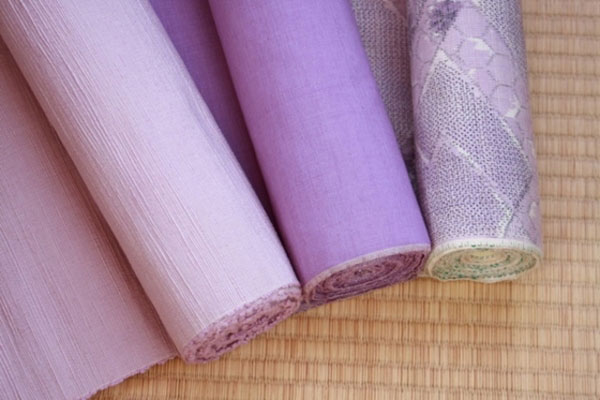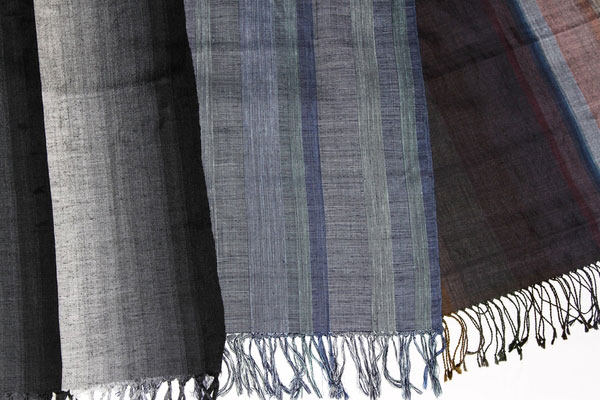
- Woven textiles
- Ibaraki
Yuki tsumugi silk Yuki tsumugi
Woven silk cherished and loved since the Nara period
Luxurious textile woven with the highest quality threads
Description
What is Yuki tsumugi silk ?
Yuki tsumugi silk is produced principally in the reaches of the Kinugawa River that straddles the Ibaraki and Tochigi prefectures. The Japanese name Yuki tsumugi comes from the name of a feudal lord during the Kamakura period (1185-1333), Yuki. Although it is considered a luxury fabric today, Yuki tsumugi silk originally started as a subsidiary business of the silk production in the region. Yuki tsumugi silk kimonos are characterized by their lightness, softness, and excellent heat retaining-properties. The threads are extracted from yarn handspun from silk floss. Silk floss are silk filaments made by boiling cocoons and gently unwinding the strands that contain air, which deliver a comfortable and gentle touch. Threads maintain their high quality without getting damaged over time. In fact, time enriches the appealing texture and increases the comfort of the fit. Therefore, Yuki tsumugi silk textile is one of the most outstanding Japanese silk fabrics that are passed down for generations.
History
 Photo:Ibaraki-Prefectural Tourism & Local Products Association
Photo:Ibaraki-Prefectural Tourism & Local Products Association
The history of Yuki tsumugi silk goes back to the Nara period (710-794), when Ibaraki prefecture was called Hitachi province. This textile is believed to have been paid to the Imperial Court as a tribute. Known as "Ashiginu" at the time, the forerunner of Yuki tsumugi silk was a silk textile woven with thick, handspun threads. With the renaming of the textile to Yuki tsumugi during the Kamakura period (1185-1333), its nationwide name recognition increased. During the Edo period (1603-1868), Tadatsugu INA, a local governor of the shogunate was active in promoting and improving Yuki tsumugi silk and a new dyeing technique was developed. The technique of tate yoko kasuri, which means vertical horizontal woven fabric, was invented in the late Taisho period (1912-1926) and yielded a significant quality improvement. An ordinary kasuri or woven fabric technique includes binding up either warp or weft threads (two basic components of thread) before weaving, but tate yoko kasuri technique is a combination of the two. Weaving with thousands of threads requires subtle craftsmanship. Post WWII technological reform led to vastly refined kasuri patterns with fine threads increasing the lightness of the fabric even more.
Production Process
- 1. Silk floss production
Producing silk floss is so difficult to master that it is said to take "eight years for spreading out silk floss and three years for spinning threads".
Cocoons are boiled in sodium bicarbonate water for two hours, then the boiled softened cocoons are gently spread out and laid in ordinary temperature water. Five to six sheets overlap each other to make a sheet of floss. Fifty sheets of floss is equivalent to a single hakari unit of measurement. A bolt of Yuki tsumugi silk fabric requires about seven hakari or 250 sheets of floss.
- 2. Spinning into yarn
Spinning into yarn is called ito tsumugi in Japanese. It is a process of spreading out silk floss and winding it around a bamboo tube that has a corn pith attached.
The wound floss spins while the strands are pulled out by one hand and collected by the other. This technique requires many years of practice.
The spun thread is placed in a special tub called oboke. It takes seven to ten days to collect a single hakari or fifty sheets of threads.
- 3. Reeling This process is spooling the threads collected in the special tub called oboke around a wooden tube. Although this may seem like a simple task, it requires a lot of experience to be able to find the right speed.
- 4. Reeling up
The threads are wound around a reel which helps with handling them in the next step.
- 5. Warping The length of the threads are made uniform by winding the threads around the warping frame and stretching them to the length of a bolt or several bolts.
- 6. Tracing the design For Yuki tsumugi silk, a design pattern is traced on special plotting paper. Design patterns have changed with times, and after the Taisho period (1912-1926), pictorial and complex patterns including splash patterns were added to the original plain, simple patterns.
- 7. Kasuri tying Kasuri tying, (kasuri kukuri in Japanese) is a process of binding specific parts together manually with cotton threads to prevent them from getting dyed. It is done according to the traced designs to create complicated, delicate patterns on the fabric. A bolt has enough width to arrange about 80 to 200 tortoise shell grids (hexagonal patterns). For 80 tortoise shell grid patterns in one width, the threads are bound in 160 places. As the number of grids becomes larger, this process becomes more complex and extremely time consuming. Kasuri tying requires three months to complete.
- 8. Dyeing
Yuki tsumugi silk uses the tataki zome technique which consists in dyeing the threads by beating them against a board to let the dye soak in.
The artisan needs to be careful because the threads are dyed too much if beaten too hard. This process requires concentration to produce an even dye. - 9. Sizing
Sizing, which is similar to starching, plays a role in strengthening the threads and preventing them from fluffing.
The concentration of the sizing liquid varies with artisans because if the liquid is too strong, the threads are affected and weaving becomes difficult. - 10. Reed drawing Reed drawing is a process of threading the warps through a comb shaped reed, which is a part of the weaving loom, with a spatula to set the threads in the loom.
- 11. Wrapping the warp thread The warp thread is wrapped around the initial thread, attached to the loom, and the weft or horizontal thread is woven by the loom.
- 12. Weaving
A strap around the weaver's waist adjusts the tension of the warp or parallel threads on the loom. The weft or perpendicular threads are woven in by the artisan with the reed. The reed is the part of the weaving loom that separates the warp threads and guides the motion across the loom. This is the longest step of the weaving process, requiring from a month to up to a year.
- 13. Inspection and dealing A wholesale dealer called a shimaya is in charge of transactions of the woven fabric after the quality check.
- 14. Desizing
This last step will be carried out before the tailoring.
Yuki tsumugi silk will be soaked in lukewarm water and be completely desized or have all of the "size" residue with a bit of starch left in the threads core.
Facility Information
Saga Prefectural Kyushu Toji Bunka Kaikan
-
Address
-
Tel.+81-296-32-1108
-
ClosedWednesdays and around the New Year
-
Business Hours10am to 4pm
-
Website
Other Woven textiles
- Nishijin brocade
- Yuki tsumugi silk
- Kurume traditional resist-dyed textiles
- Ojiya chijimi textiles
- Hakata brocade
- Ushikubi tsumugi silk
- Chichibu-meisen silk
- Miyako ramie textile
- Shiozawa tsumugi silk
- Kumejima tsumugi silk
- Omi ramie cloth
- Ryukyu traditional resist-dyed textiles
- Kiryu brocade
- Murayama-oshima tsumugi silk
- Yumihama traditional resist-dyed textiles
- Chibana-hanaori textiles
- Hon-shiozawa silk
- Oitama tsumugi silk
- Ojiya tsumugi silk
- Yaeyama cotton cloth
- Yaeyama ramie cloth
- Honba oshima tsumugi silk
- Shinshu tsumugi silk
- Shuri brocade
- Tama brocade
- Yomitanzan-hanaori textiles
- Isesaki traditional resist-dyed textiles
- Hachio island silk
- Nibutani bark cloth
- Uetsu tilia bark cloth
- Awa-shijira cotton cloth
- Kijoka banana fiber cloth
- Tokamachi traditional resist-dyed textiles
- Tokamachi akashi chijimi textiles
- Yonaguni brocade
- Yuntanza minsa
- Flower pattern textiles
- Oku-Aizu Showa Karamushi Textiles

































































































































































































































































































